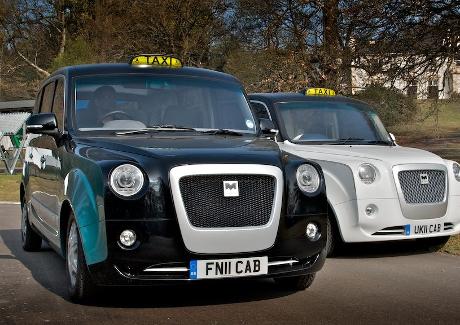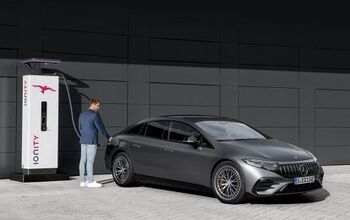A Different Kind of London Taxi & A Different Kind of British Car Magazine

An editor that I know once said something about disappearing into a rabbit hole when you start to read about an automotive topic. You never know where you’ll come out minutes, hours or even days later. Doug DeMuro’s post where he ranked vehicles used as taxicabs elicited a thread of comments about London’s signature black taxis. While some of our more curmudgeonly readers think it’s rather arrogant of TTAC to call our site’s commenters the Best & Brightest (anyone besides me see the irony there?), we do have a well informed readership so I wasn’t surprised to see Geely mentioned as the owner of Manganese Bronze Holdings, who make the distinctive London hacks. The mention of the London cabs, though, pricked my memory. I had recently read that someone else, another company, made London taxis besides Manganese. Then I just had to remember who it was.
Fortunately my impaired memory still knows how to access the history file on my web browser. The name of the company is Metrocab and it’s currently part of the Frazer Nash group of companies, a firm that traces its roots back to Achibald Frazer Nash’s sports car company, founded in 1922. I found out about Frazer Nash’s current incarnation, owned by Kamal Siddiqi, while down another rabbit hole, reading about the Bristol automobile company. Siddiqi’s Kamcorp bought Bristol out of receivership in 2011. The specialist carmaker continues to provide service to Bristol owners as it plans to go back into production with a new model car.
Kamcorp also bought Metrocab out of bankruptcy back in 2001. That’s not the first, or second time Metrocab has gone through a bankruptcy or change of ownership. In the 1950s, body builder Weymann took over production of the Beardmore Mk 7 taxicab. Beardmore was one of a number of car makers competing for London cab operators’ business. In 1966 Weymann’s successor company, Metro Cammell Weymann, ended production of that model and started development of its replacement. That took a while. When finally on sale in 1987, the purpose built taxi was called the MCW Metrocab. In 1989, the Reliant car company, known for its Robin three wheelers and Jalopnik writer Jason Torchinsky’s Scimitar, bought Metrocab, only to find itself in receivership two years later. Coachbuilder Hooper then bought the assets of Metrocab, but in late 2000 sale of shares were suspended and all production employees were laid off. Kamcorp bought the assets the following year, reorganizing them under the Metrocab name, but the taxi manufacturer has continued to struggle.
Production was shut down for 14 months in 2004 and 2005 and then again in 2006, apparently permanently, but with an infusion of cash from GENII Capital of Malaysia last year, and engineering help from Lotus, also controlled by GENII, Frazer Nash has announced that they will be producing an all-new London taxi, to be assembled in an Italian factory that formerly built forklifts. It will be a range extended electric vehicle, like the Chevy Volt, using technologies developed by a Frazer Nash subsidiary. As you can see from the photos, unlike Henry Ford’s Model T (well, the ones made after 1914) and the original London taxis, you’ll be able to get them in colors other than black. A fleet of seven Metrocab EREVs have gotten conditional approval by London taxi authorities to begin real world testing.
That isn’t what this post is about, though.
It’s about Taxi, the official publication of the Licensed Taxi Drivers Association of the UK, which I found down one of the tunnels in the rabbit hole. There I was able to find much of the information about the new Metrocab in their July 10, 2012 issue. The ads in Taxi are for cab insurance, used taxis, the GetTaxi London Cab smartphone app and guaranteed rebuilt engines for Manganese cabs. The articles are about the legal and financial struggles of taxicab operators. It makes for fascinating reading, well, that is if you find automotive subcultures interesting. It’s not exactly L.J.K. Setright era CAR (Setright, alav hashalom, loved Bristols, by the way), but it’s a perspective on a part of the British motoring scene that you might not otherwise get. If you want to check it out, you can download the latest issue here.
Speaking of professional cars, I saw a MKT limo like Lincoln is promoting to the livery business, behind a hearse in a funeral today. While the MKT Town Car might be suitable for “black car” service in American cities, I think a Ford Edge would make a better London Taxi than a stretched MKT. Come to think of it, the Metrocab might look better on American streets than the awkwardly styled MKT.
Ronnie Schreiber edits Cars In Depth, a realistic perspective on cars & car culture and the original 3D car site. If you found this post worthwhile, you can get a parallax view at Cars In Depth. If the 3D thing freaks you out, don’t worry, all the photo and video players in use at the site have mono options. Thanks for reading – RJS

Ronnie Schreiber edits Cars In Depth, the original 3D car site.
More by Ronnie Schreiber
Latest Car Reviews
Read moreLatest Product Reviews
Read moreRecent Comments
- SCE to AUX Sure, give them everything they want, and more. Let them decide how long they keep their jobs and their plant, until both go away.
- SCE to AUX Range only matters if you need more of it - just like towing capacity in trucks.I have a short-range EV and still manage to put 1000 miles/month on it, because the car is perfectly suited to my use case.There is no such thing as one-size-fits all with vehicles.
- Doug brockman There will be many many people living in apartments without dedicated charging facilities in future who will need personal vehicles to get to work and school and for whom mass transit will be an annoying inconvenience
- Jeff Self driving cars are not ready for prime time.
- Lichtronamo Watch as the non-us based automakers shift more production to Mexico in the future.







































Comments
Join the conversation
A great example of search engine journalism! No sarcasm meant. It takes a great deal of discipline to spend hours or days to follow all of those "rabbit holes." just the links from this story could result in hours of interesting browsing. I have to compare riding in a cab in London vs Manhattan (insert Chicago, San Fran, Seattle, Berlin, Rome, Shanghai, Los Angeles: I wasn't in fear for my life. The article is correct in another respect, once away from London, the cab experience in the UK becomes a mixed bag for quality.
The London Taxi (and it is used in many cities in GB) is uniquely designed to meet the demands of London streets and traffic. They apparently will u-turn in an alley and run all day on 2 liters of diesel. I do not know how many can be crammed in one as no doubt there are laws preventing this from being achieved. Another unique value of the London cab is its ability to point to a cheap place to get a breakfast or lunch (other then the M&S or Tesco marts). Cab drivers know all the best and cheap hangouts. I like the hole in the wall around the corner from Gloucester Rd tube station.